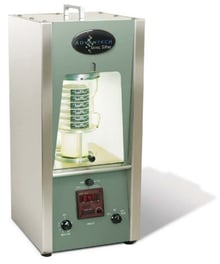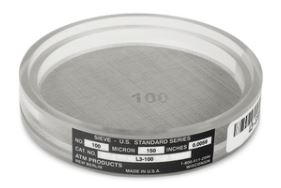How To Assemble the Test Sieve Stack of a Sonic Sifter Separator
If you are familiar with test sieve analysis, you know that it has been regarded as one of the most reliable and practical forms of particle analysis. Reflected in dozens of industry standards, sieve shakers and test sieves have been prominent pieces of particle analysis equipment.
That said, the way in which you orient your sieves, from making sure they flush when stacked to the order they are in, plays an integral role in the success of your test. The same goes when conducting a sonic sifter analysis, an identical variant of test sieve analysis.
If you are upgrading your current test sieve analysis set up or looking to build a new lab setting around Sonic Sifter Analysis, it is important to understand that assembling a sonic sifter test sieve stack is slightly more involved than a standard sieve shaker sieve stack. After spending the past 140 years embedding the importance of particle analysis in dozens of industries, W.S. Tyler realizes that accuracy is critical no matter what you are testing and strives to share our experiences to help you accurately set up your process.
This includes how to properly sonic sifter test sieve stack.
To help you understand what a sonic sifter sieve stack looks like and how to set one up, this article will cover:
- What an L3P Sonic Sifter Separator is
- The Components that Make up a sonic sifter sieve stack assembly
- How to properly assemble a sonic sifter test sieve stack
What Is a L3P Sonic Sifter Separator?
The L3P Sonic Sifter is a particle size analysis device developed to deliver precise and repeatable results. Using a sonic wave generated from an oscillating air column, the L3P Sonic Sifter works to sieve fine particles with similar functionality of a standard wet sieve analysis.

When compared to other particle size analysis methods, the sonic sifting process is signally quicker. This, as well as the fact that minimal maintenance is needed, makes this device an efficient option for virtually any quality control program.
What Components Control the L3P Sonic Sifter Separator?
Other than the main body of the unit itself, there are several components that help the L3P Sonic Sifter function. This includes the column lock, diaphragm, top cone, acrylic spacers, fine particles collector, and fine particles collector (base).

The column lock is a metal mechanism that holds the sieve stack assembly in place by locking the fine particles collector in place within the test sieve chamber of the unit. The locking mechanism is disengaged once placed into the test sieve chamber, with the assembly tensioning holding everything together when conducting a particle analysis.
Once testing is complete, the locking mechanism is engaged after testing allowing for the sieve assembly to be removed easily and safely.
The diaphragm is a latex disk that covers that blankets the particles located in the top cone, hindering their ability to fall out and creating a messy testing environment. This component also helps facilitate particle separation throughout the sieve stack as it reacts to aid the sonic wave within the air column.
NOTE: As the diaphragm is made of latex, it is known to wear over time and is given an expiration date.
The top cone is a clear acrylic funnel that allows for sample material to be loaded easily. This particular component also works to project the sonic waves throughout the column to further help the particles find the openings in the test sieve mesh.
Acrylic spacers are ⅝" tall rings that serve to supplement missing sieves in a stack that is not full height.
The fine particles collector is the latex pocket that rests at the bottom of the sieve stack in order to catch the fine particles that pass through the bottom-most sieve in the stack.
Lastly, the fine particle collector holder is the metal base that not only secures the fine particle collector in place but serves as an anchoring medium that the column lock attaches to in order to keep the assembly intact.
How to Setup the Sieve Assembly?
To properly assemble your sieve stack, you must first place the fine particles collector into the fine particles collector holder. When in the correct position, the hook at the bottom of the collector should be attached to the holder to ensure a secure operation.
You can then begin assembling your test sieve stack. To do so, place the finest sieve at the bottom, going up in the correct order until the coarsest sieve is placed at the top.
If your test sieve stack is limited, you can insert the included acrylic spacers to fill out the rest of the stack.
Once your sieve stack is complete, top it off with the top cone prior to loading your sample material. After the top cone is in its proper position, you can load your sample then place the diaphragm on top of the top cone.
The column lock should now be placed and secured on top of the test sieve stack. Place the assembly in its entirety into the test sieve chamber of the device, manually unlocking the securing arms of the column lock once the assembly is in place.
At this point, simply lower the protective door on the unit and begin your particle separation process.
Understand the Sonic Sifter Analysis Process
When you receive an L3P Sonic Sifter Separator, you will receive everything you need to build your sieve stack (sold separately), including Column Lock, diaphragm, top cone, acrylic spacers, fine particles collector, and fine particles collector. It's essential that each component is securely in its rightful place to ensure you are gathering results that are accurate, repeatable, and a true representation of the material throughout your production line.
But with a lot of particle analysis operations, the results you obtain are only as reliable as the practices you employ to achieve them. This is why it is critical that you know what a successful sonic sifter analysis looks like and how to conduct one.
We understand that accurate results are of the utmost importance and strive to partner with our customers to learn their specific needs and serve a relief aid. This is why we eagerly look to help particle analysis labs understand and explore the best practices that surround the particle analysis industry.
With that, to help you better understand how a sonic sifter analysis works, so you and your staff are well versed, read the following article:
About Ronnie Brown
Ronnie is the Content Writer for W.S. Tyler and has four years of experience as a professional writer. He strives to expand his knowledge on all things particle analysis and woven wire mesh to leverage his exceptional writing and graphic design skills, creating a one-of-a-kind experience for customers.




